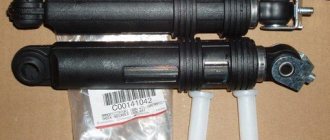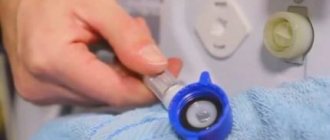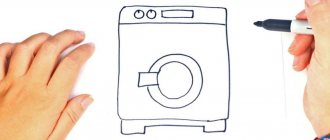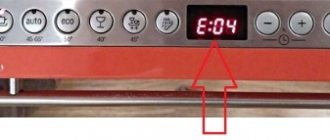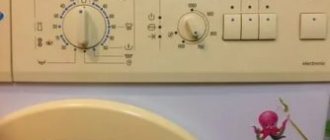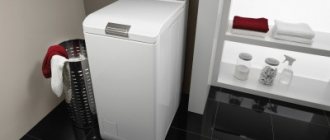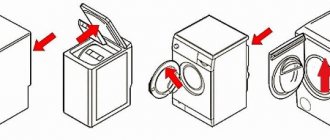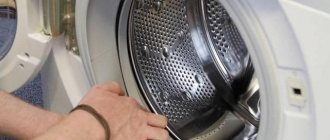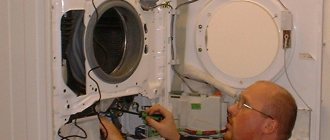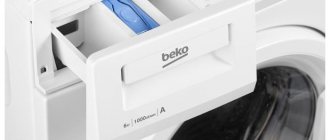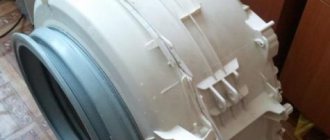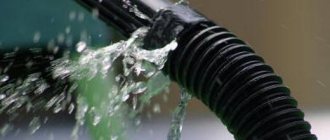Typical malfunctions of Siemens washing machines
German technology is actually considered to be of high quality in all its components. Experts assure that if we compare with other washing machines, then in Siemens the engine, control module and bearings can be distinguished in terms of reliability. The listed elements rarely fail.
But the following failures are identified as weak points:
- The wash ended, but the water did not drain, the program did not switch to rinse or spin. In this case, the likely failure will be failure or clogging of the pump,
- The machine takes in water and immediately drains it. The problem may be with the fill valve. One sign of a problem is water leaking near the detergent dispenser,
- water flow. As a rule, this happens near the door or under the body. The reason is the wearing of the cuffs or their weakening,
- no water heating. In most cases, the problem is related to the heating element,
- When the machine is operating, vibration is observed and knocking is heard. In such situations, it is recommended to check shock absorber devices and dampers for wear.
Repair of Siemens washing machines
Washing machines under the Siemens are produced by the German concern BSH Hausgeräte GmbH. The history of Siemens dates back to 1847. The first washing machine was released in 1928, in 1932 a machine with the ability to change the direction of movement of the drum and the water temperature during washing. In 1960, Siemens released the first automatic washing machine. In 1985, Siemens washing machines appeared on the market, equipped with the Aqua Stop system to protect against leaks. In 1996, Siemens released washing machines with sensors to determine the degree of water contamination, and in 2003 it released machines with a stain removal program. Siemens washing machines are produced in Germany, China, Spain, and Turkey. In Russia, several models are assembled in St. Petersburg.
Siemens washing machines belong to the price segment: above average, upper, premium. Some models can be classified as the middle segment. The design of Siemens machines is simple, concise and versatile. The color is mostly white and silver, rarely black. Siemens washing machines provide maximum efficiency and quality of work, many programs, child lock, the ability to reload laundry, delayed start. If used properly, washing machines may not require repairs for many years. The manufacturer continues to produce spare parts for 10 years from the date the model is discontinued.
Quick online diagnostics of washing machine faults (Just select a problem from the list and find out the approximate breakdown)
Most modern Siemens washing machines have the function of displaying an error code when certain malfunctions and malfunctions occur. Quite often, understanding what the error code means , you are able or breakdown yourself
For your convenience, a list of error codes for Siemens washing machines is provided with an explanation of each specific code . The table also includes a description of the error, the reasons for its occurrence and possible solutions.
The washing machine consists of units that are complex in design, and if they break down, it is better not to try to repair the devices yourself. Moreover, this is due to high voltage and the possibility of flooding neighbors living on the floor, or even two or three floors below.
When carrying out repairs yourself, remember your safety!
Disassemble without disconnecting the equipment from the mains!
It is best to use the services of an experienced technician who is familiar with any problems and can fix the problem. If your washing machine breaks down, entrust the repair to a professional: he will be able to perform all the steps quickly, efficiently and safely.
Decoding Siemens error codes
| Error code | Description of the error | Causes and elimination |
| F01 | The loading hatch door is not closed. | Check that the door is closed tightly or re-place the laundry in the drum so that no item is caught in the door. |
| F02 | No water supplied. | 1. The tap for supplying tap water to the washing machine is closed. 2. Low water pressure in the tap or the water is turned off. 3. The mesh in the water supply hose to the machine is clogged. |
| F03 | Water does not drain. | The error appears if the washing machine takes 10 minutes. did not drain the water from the tank. 1. Clean the filter, make sure there are no blockages in the pipes and hoses. 2. Check the operation of the drain pump. 3. The drain pump impeller must have free movement when rotating to the right/left. If this is not the case, the pump must be replaced (the resistance of the pump coil is about 200 Ohms). 4. The cause of the defect may also be caused by a malfunction of the electronic controller of the washing machine. |
| F04 | There is a water leak. | Look for the source and check the tightness of the connections. |
| F16 | The hatch door is not closed | 1. The washing program does not start. 2. Restart the program, if possible. 3. Close the door. |
| F17 | The water supply time has been exceeded: 1. The water supply valve is closed; 2. The water inlet filter is clogged; 3. Pressure when water enters is less than 1 bar. | 1. Open the water supply tap. 2. The program will stop, the pump will start draining after 5 minutes. 3. It is possible to start the program again. |
| F18 | The water drain time has been exceeded: 1. The drain pump is faulty or clogged; 2. Level N1 is not reached; 3. The pressure switch is blocked; 4. Malfunction of the water level controller. | 1. Clean the drain pump. 2. The program is canceled and the “IMPORTANT FAULT” mode is activated if there is no drainage within 90 seconds. |
| F19 | The water heating time has been exceeded: 1. Malfunction of the heating system; 2 Thermostat not reached; 3. Low voltage in the network; 4. Lime deposits on the heating element or malfunction of the heating element. | 1. Check the heating element and its connecting circuits. 2. The program will end without heating. |
| F20 | Unexpected heating: 1. Temperature sensor (NTC) is faulty; 2. The heating element relay is faulty; 3. Heating occurs during a period when there should not be heating. | The program is canceled and the “IMPORTANT FAULT” mode is activated. |
| F21 | Malfunction of the control system, uneven operation of the drive motor, drive motor does not rotate drum 1. Short circuit of triacs; 2. Tachogenerator malfunction; 3. Reverse relay is faulty. | 1. After several attempts to start the electric motor, the program is canceled and the “IMPORTANT FAULT” mode is activated. 2. Attempts to start the engine occur before the program is completed. |
| F22 | NTC sensor (temperature sensor) fault: 1. NTC short circuit; 2. NTC sensor malfunction; 3. Breakage of connecting circuits. | The program will end without heating. |
| F23 | Aquastop is activated: 1. Water has collected in the tray of the washing machine; 2. Breakage of connecting circuits. | 1. Check the water system for leaks. 2. Check the aquastop. 3. Check the connecting circuits for breaks. |
| F25 | Malfunction of the Aqua sensor (water turbidity sensor): 1. Lime deposits on the Aqua sensor; 2. Malfunction of the pressure switch; 3. The water drainage system is clogged. | The program will end without rinsing. |
| F26 | Malfunction of the analogue pressure sensor (protects against voltage errors) or malfunction of the pressure sensor (pressostat). | Critical error Program cancelled, pump removes water, door is blocked, control processes are blocked, indication is blocked. 1. Press ON/OFF to reset. 2. Check the pressure sensor. 3. Check the connecting circuits for open circuits. |
| F27 | Error in setting the pressure sensor or malfunction of the pressure sensor (pressostat). | The setting has not been carried out, the work is based on the old values. 1. Check the pressure switch. 2. Check wiring. |
| F28 | Flow sensor malfunction (provides an impossible value) | The passage of a volume of water per unit time. 1. Check the flow sensor. 2. Check wiring. |
| F29 | No water passage was detected in the flow sensor: 1. The water supply valve is closed; 2. Water inlet pressure 3. Water inlet filter clogged; 4. Magnetic valve malfunction; 5. Malfunction of the aquastop magnetic valve; 6. Pressure sensor malfunction. | Stopping the washing program, the pump will start draining after 5 minutes, it is possible to restart the program. 1. Open the water supply tap. 2. Check the components. 3. Check wiring. |
| F31 | The maximum water level has been exceeded: 1. The pump is blocked; 2. The water removal hose is blocked; 3. Magnetic valve malfunction; 4. Incorrect pressure sensor setting; 5. Malfunction of the pressure sensor (pressostat); 6. Blocking of the water removal system. | Once water is removed to an acceptable level, the program will lengthen. 1. Check the water supply valves. 2. Check the pump. 3. Check the pressure sensor (pressure switch). 4. Check the water removal system. 5. Check wiring. |
| F34 | The door lock does not close: 1. The lock is faulty; 2. The tongue is stuck; 3. The door is stuck; 4. The gasket is not elastic. | Critical error Program cancelled, door blocked, control processes blocked, indication blocked. 1. Press ON/OFF to reset. 2. Check the door lock. 3. Check the mechanics. 4. Check wiring. |
| F36 | The lock system is faulty: Module fault (triac is faulty or relay is faulty). | Critical error Program cancelled, door blocked, control processes blocked, indication blocked. 1. Press ON/OFF to reset. 2. Check the control module. 3. Check wiring. |
| F37 | NTC (temperature sensor) faulty | The program ends without heating. 1. Check NTC. 2. Check wiring. |
| F38 | Malfunction NTC (temperature sensor) short circuit. | The program ends without heating. 1. Check NTC. 2. Check wiring. |
| F40 | Synchronization error: Power supply values are not within acceptable limits. | |
| F42 | Uncontrolled high engine speeds: Module malfunction - the triac is faulty. | Critical error Program cancelled, door blocked, control processes blocked, indication blocked. 1. To reset, run the test program. 2. Check the module. |
| F43 | The engine does not rotate: 1. Tachogenerator malfunction; 2. Laundry is stuck between the tub and the drum; 3. Motor/drum blocking; 4. Module malfunction - the triac is faulty. | Critical error Program cancelled, door blocked, control processes blocked, indication blocked. 1. To reset, you need to run the test program. 2. Check the load level. 3. Check the tachogenerator. 4. Check the module. 5. Check wiring. |
| F44 | There is no rotation in the opposite direction - Module malfunction: 1. The triac is faulty; 2. Reverse relay is faulty. | Critical error Program cancelled, door blocked, control processes blocked, indication blocked. 1. To reset, you need to run the test program. 2. Check the module. |
| F59 | 3D Sensor: measurement error, value too high or too low: 1. Break in wiring; 2. Power module malfunction; 3. 3D sensor malfunction; 4. SoftWare error. | Decreasing speed. 1. Check the wiring. 2. Check the 3D sensor. 3. Check the position of the magnet. 4. Check the module. |
| F60 | Flow sensor, value detected too high or too low: 1. Flow sensor faulty; 2. Turbulent swirl in the sensor or tubes. | The passage of a volume of water per unit time. 1. Check the flow sensor. 2. Check the filter in the fill valve. 3. Check wiring. |
| F61 | Invalid door signal: 1. Door open or closed; 2. The security lock is activated. | Critical error Program cancelled, door blocked, control processes blocked, indication blocked. 1. Press ON/OFF to reset. 2. Check the door lock. 3. Check the mechanics. 4. Check wiring. |
| F63 | Functional protection problem: 1. The processor is faulty; 2. Software error. | Critical error Program cancelled, door blocked, control processes blocked, indication blocked. 1. Press ON/OFF to reset. 2. Check the power module. |
| F67 | Card encoding error: 1. The encoding between the power and control modules was carried out incorrectly; 2. The software between the power and control module is inappropriate. | Critical error Program cancelled, door blocked, control processes blocked, indication blocked. 1. Press ON/OFF to reset. 2. Re-encode the card. 3. Replace the card. |
| E02 | Problem with the drive motor. | 1. Check the motor brushes. 2. Check the motor resistance. 3. Check the connection contacts. 4. Check the motor module or main module. |
| E67 | Incorrect control module coding. | Possibly a firmware glitch. 1. Call a technician and reprogram the module. 2. Or replace the module with a new one or a similar one. |
How to call a specialist?
Requests for repairs are accepted daily, from 8 am to 10 pm by phone or using an online application.
8 (985) 181 – 02 – 88
8 (985) 181 – 02 – 88 (Whatsapp)
Leave a request for repairs
Important! When contacting, please provide the following information: Your contact information: name, phone number and address, make of the machine, if possible, send a tag with the serial number and product code of the machine and the day and time of arrival of the technician that suits you.
To carry out repairs and select spare parts for your washing machine, you need to know its model and serial number.
The exact model of the machine is indicated on the tag on the body of the washing machine or stickers, as well as in the operating instructions. If you have already purchased replacement parts yourself, please indicate only the make of the machine. For example, SIEMENS S1 WTF 3800 A.
places where washing machines may contain a sticker with all the necessary service information.
1. Under the hatch door on the body. Most often, on front-type washing machines, the serial number is located on a sticker under the hatch door. Either on the door itself or on the body. In most cases, the number consists of numbers, less often of numbers and letters .
2. On the back side of the pump filter hatch. On vertical models, a sticker with a service number is most often located on the inside of the small hatch that covers the pump filter.
3. On the back wall. The back wall of the washing machine is a traditional place for all kinds of service information. If you couldn’t find a sticker with a number on the front, then it was probably preserved on the back wall.
4. In the passport or instruction manual. Finally, the serial number can sometimes be found in the documents that come with the purchase of the washing machine. As a rule, the number is located in the passport or warranty card.
The arrows show the location of the tags.
washing machine manufacturers encode on a tag (sticker) what they produced, when, where and from what parts. This information is encoded in two sequences of numbers (letters) product and serial numbers. Their combination is unique and applies only to one specific instance of the washing machine.
Please take a photo of these tags
To maximize the life of your washing machine, you need to carefully read the operating instructions. If you have lost it, here you can select your model and download it in pdf format.
Siemens washing machine operating instructions
| SIEMENS S1 WTF 3002 A | SIEMENS WD 14H420 EU | SIEMENS WDI 1441 |
| SIEMENS WI 14S440 OE | SIEMENS WIQ 1630 | SIEMENS WIQ 1833 |
| SIEMENS WM 10E443 OE | SIEMENS WM 10E144 | SIEMENS WM 10E464 |
| SIEMENS WM 10S45A OE | SIEMENS WM 10S47A OE | SIEMENS WM 12E144 OE |
| SIEMENS WM 12E444 | SIEMENS WM 12Q440 OE | SIEMENS WM 12S45A OE |
| SIEMENS WM 12S47A OE | SIEMENS WM 14Q441 | SIEMENS WM 14S46 A |
| SIEMENS WM 14S741 | SIEMENS WM 14S743 OE | SIEMENS WM 14Y790 |
| SIEMENS WM 16S741 OE | SIEMENS WM 16S74 S | SIEMENS WM 16S890 |
| SIEMENS WM 16Y790 | SIEMENS WS 10F261 | SIEMENS WS 10G240 |
| SIEMENS WS 10M441 | SIEMENS WS 10X161 | SIEMENS WS 10X35A OE |
| SIEMENS WS 10X440 | SIEMENS WS 10X47 A | SIEMENS WS 12G240 |
| SIEMENS WS 12M440 | SIEMENS WS 12O240 | SIEMENS WS 12X163 OE |
| SIEMENS WS 12X45 A | SIEMENS WS 12X47 A | SIEMENS WT 46S515 |
| SIEMENS WXL 961 BY | SIEMENS WXLP 120 A | SIEMENS WXS 1063 |
| SIEMENS WXS 863 | SIEMENS S1 WTF 3003 A | SIEMENS WD 14H441 |
| SIEMENS WDI 1442 | SIEMENS WIQ 1430 | SIEMENS WIQ 1631 |
| SIEMENS WK 14D540 | SIEMENS WM 10E144 OE | SIEMENS WM 10E444 |
| SIEMENS WM 10Q440 | SIEMENS WM 10S46 A | SIEMENS WM 12E143 |
| SIEMENS WM 12E44 A | SIEMENS WM 12E444 OE | SIEMENS WM 12Q441 |
| SIEMENS WM 12S46 A | SIEMENS WM 12Y590 | SIEMENS WM 14S44 A |
| SIEMENS WM 14S46 A OE | SIEMENS WM 14S741 OE | SIEMENS WM 14Y590 |
| SIEMENS WM 16S740 | SIEMENS WM 16S742 | SIEMENS WM 16S74S OE |
| SIEMENS WM 16S890 EU | SIEMENS WM 16Y890 | SIEMENS WS 10F261 OE |
| SIEMENS WS 10M341 | SIEMENS WS 10O140 | SIEMENS WS 10X161 OE |
| SIEMENS WS 10X36A OE | SIEMENS WS 10X45 | SIEMENS WS 10X47A OE |
| SIEMENS WS 12M340 | SIEMENS WS 12M440 OE | SIEMENS WS 12X160 |
| SIEMENS WS 12X37 A | SIEMENS WS 12X45A OE | SIEMENS WS 12X47A OE |
| SIEMENS WT 46W561 BY | SIEMENS WXLI 4240 | SIEMENS WXLS 120 A |
| SIEMENS WXS 1065 | SIEMENS WXSP 100 A | SIEMENS S1 WTF 3800 A |
| SIEMENS WD 14H540 | SIEMENS WDI 1442 EU | SIEMENS WIQ 1432 |
| SIEMENS WIQ 1632 | SIEMENS WM 10E143 | SIEMENS WM 10E160 BY |
| SIEMENS WM 10E444 OE | SIEMENS WM 10S44 A | SIEMENS WM 10S46A OE |
| SIEMENS WM 12E143 OE | SIEMENS WM 12E443 | SIEMENS WM 12E463 |
| SIEMENS WM 12S44 A | SIEMENS WM 12S46A OE | SIEMENS WM 14E44 A |
| SIEMENS WM 14S45 A | SIEMENS WM 14S47 A | SIEMENS WM 14S742 |
| SIEMENS WM 14Y590 OE | SIEMENS WM 16S740 OE | SIEMENS WM 16S742 OE |
| SIEMENS WM 16S75S | SIEMENS WM 16SD740 | SIEMENS WM 53661 BY |
| SIEMENS WS 10G140 | SIEMENS WS 10M440 | SIEMENS WS 10O240 |
| SIEMENS WS 10X163 | SIEMENS WS 10X37 A | SIEMENS WS 10X45A OE |
| SIEMENS WS 12G140 | SIEMENS WS 12M340 OE | SIEMENS WS 12M441 |
| SIEMENS WS 12X161 | SIEMENS WS 12X37A OE | SIEMENS WS 12X46 A |
| SIEMENS WT 46S513 BY | SIEMENS WXL 1141 BY | SIEMENS WXLI 4240 EU |
| SIEMENS WXLS 140 A | SIEMENS WXS 107 A | SIEMENS WXSP 120 A |
| SIEMENS WD 14H420 | SIEMENS WDI 1440 EU | SIEMENS WI 14S440 |
| SIEMENS WIQ 1433 | SIEMENS WIQ 1633 | SIEMENS WM 10E143 OE |
| SIEMENS WM 10E443 | SIEMENS WM 10E463 | SIEMENS WM 10S45 A |
| SIEMENS WM 10S47 A | SIEMENS WM 12E144 | SIEMENS WM 12E443 OE |
| SIEMENS WM 12Q440 | SIEMENS WM 12S45 A | SIEMENS WM 12S47 A |
| SIEMENS WM 14Q440 | SIEMENS WM 14S45A OE | SIEMENS WM 14S740 |
| SIEMENS WM 14S742 OE | SIEMENS WM 14Y79 | SIEMENS WM 16S741 |
| SIEMENS WM 16S743 OE | SIEMENS WM 16S75S OE | SIEMENS WM 16Y74S |
| SIEMENS WS 10F260 | SIEMENS WS 10G160 | SIEMENS WS 10M440 OE |
| SIEMENS WS 10X160 | SIEMENS WS 10X35 | SIEMENS WS 10X37A OE |
| SIEMENS WS 10X46A OE | SIEMENS WS 12G24 S | SIEMENS WS 12M341 |
| SIEMENS WS 12O140 | SIEMENS WS 12X163 | SIEMENS WS 12X440 |
| SIEMENS WS 12X46A OE | SIEMENS WT 46S514 BY | SIEMENS WXL 960 BY |
| SIEMENS WXLP 100 A | SIEMENS WXS 1062 | SIEMENS WXS 862 |
| SIEMENS WXTS 121 A |
Washing machines from manufacturers that we repair
Advice from professionals, preventive measures
If you want to wash the outside of the washing machine, you must turn off the power to the unit and do not use a stream of water or chemical detergents containing solvents or abrasive components. It will be better if you simply wipe the case with a damp cloth.
It is necessary to remove scale from the elements of the washing machine using special means, using them in accordance with the recommended dosages.
The detergent drawer should be inspected regularly. If there is dirt or powder residues in it, remove it, rinse thoroughly, and return it to its original place.
The condition of the water pump should be checked several times throughout the year. For this procedure, the base wall is removed, the drain hose is pulled out, and the liquid is drained. After this, the pump is cleaned and the impeller is checked for rotation. Then the pump cover is installed in its place and the panel is attached.
At least once a year, it is necessary to remove and check the filter located in the water intake hose of the washing machine.
Problems with the drive part
If the washer suddenly stops the drum, then first of all the drive belt is checked - it is responsible for transmitting the impulse from the motor to the drum shaft. If the rubber band breaks or falls off, the cylinder stops rotating. To adjust the drive, it is necessary to return the “ring” to its place.
It’s worse if the belt breaks constantly, more than three times every 6 months. In such a situation, it is not enough to simply return the rubber band to its place: the condition of the rim and pulley must be assessed. Perhaps the wheel was deformed and the ring stretched. Then you will need to repair or replace components.
Before making a “diagnosis”, you need to inspect the belt. The instructions on what to do are as follows:
- disconnect Siemens from power supply and water supply;
- turn the equipment with the back panel forward;
- unscrew the “back” by loosening the corresponding bolts;
- inspect the pulley and assess the condition of the belt.
Is the belt on the pulley? This means that the problem with the stopped drum is not in the drive. If the rubber has fallen off, you should carefully inspect it and the wheel for defects. If there is no damage or stretching, you can return the rim to its place, otherwise you will have to replace it with a new one.
The new drive belt is selected taking into account the serial number of the Siemens washing machine.
If the belt slipped the first time and remained intact, then it’s too early to sound the alarm. It is enough to pull the elastic band back and start the test cycle. It’s another matter if the leak occurs repeatedly: then you need to move on to the rubber element or pulley repair. In the second case, we proceed like this:
- fix the wheel motionless by holding a screw or stick between the blades;
- pour WD-40 lubricant over the central bolt and wait 15-40 minutes for the product to “work”;
- Use a suitable ratchet to loosen the bolt (do not apply force, otherwise the thread will break);
- remove the wheel from the shaft;
- we purchase a new pulley;
- We fix the new pulley on the shaft by tightening the central screw.
The drive belt is put on the new pulley. First, we put the rubber band on the motor shaft, and then we pull it onto the drum pulley. The new elastic band is stretched very tightly, be prepared for this.
Let's pay attention to the engine
The drum also stops if there are problems with the engine. The motor does not accelerate, and the shaft, like the cylinder, remains motionless. More often than not, the collector motor “fails,” since these devices have several typical breakdowns:
- worn out electric brushes;
- peeled lamellas;
- winding break.
Diagnosing and repairing a motor is not an easy task. First, you need to remove the device from the washing machine body. Secondly, test it for serviceability using a multimeter. It is important to act sequentially: first check the general condition of the engine, then measure the length of the carbon brushes, inspect the lamellas and “ring” the winding for breakdown.
Replacement components are selected depending on the serial number of the existing Siemens washing machine.
If you suspect an engine breakdown, it is recommended to contact a service center. If you can replace the electric brushes yourself, then professionals should test the motor itself, grind the lamellas and do the winding. Sometimes repairs are useless - only replacing the engine.
Getting rid of unnecessary errors
The self-diagnosis system on modern Siemens works properly - it immediately notices a failure and displays the corresponding error code on the display. But after fixing the problem, the user must inform the board that the repair is complete. In simple words, you need to manually reset the signal combination. The algorithm for restarting the self-diagnosis system depends on the Siemens model. However, the difference is insignificant. As a rule, it is enough to do the following:
- turn the program selector to position “0”;
- move the programmer one more division to the left;
- hold down the “Start” button for 2-3 seconds;
- Scroll the selector to the starting position.
Sometimes you need to reset an error on Siemens several times - the system takes a long time to process the command.
If everything is done correctly, then after a while the error will be reset and the machine will be ready for use. Sometimes the system does not accept the command for a long time - you need to repeat the procedure 2-3 times. On some Siemens models, instead of “Start” you should press “Spin”. It is better to clarify the sequence of actions in the factory instructions.
Something foreign is stuck in the tank
The reason for the sudden stop of the drum may be a foreign object stuck in the machine. Keys, coins and hairpins that get into the washer can fall into the tank, get caught in the hole in the tank and cause the shaft to jam. As a result, Siemens will grind to a halt. Drum jamming is a serious matter. Attempts to unwind the cylinder manually or restart the wash will lead to serious consequences: mechanical damage and deformation of both containers.
Before washing, check the pockets of items loaded into the drum - forgotten items can cause jams and clog the drain.
To free the drum, you need to remove the stuck object from the tank. The easiest way to do this is through the hole in the heating element, especially if the heater is located at the back wall. What should I do?
- Disconnect Siemens from the power supply.
- Shut off the water supply.
- Drain the water through the emergency drain or garbage filter (if the washing machine stops during the washing process).
- Detach the back wall from the housing.
- Find a heating element under the tank, or rather, its rounded chip with connected wires.
- Take a photo of the location of the wires.
- Disconnect the terminals.
- Loosen the central fastener.
- Remove the heating element (if it is stuck, use WD-40).
- Through the resulting hole, remove the stuck object using your hand or a wire bent into a “hook”. At the same time, remove all the debris accumulated at the bottom of the tank.
If the heater on Siemens is located near the front panel, it is recommended to remove the stuck object through the drain hole. It is enough to put the machine on its side, unscrew the pan, release the drain pipe and catch the “lost thing” with your hand.
Circuit
More often, the reason for the lack of power is trivial - there is no light in the room or the entire apartment. Especially if the washing machine is located in a country house or a sparsely populated area where problems with electricity periodically arise. Therefore, the first thing we do is flip the switch, checking whether there is power supply in the room.
If there is no light, then pay attention to the panel: are the machines activated, are the plugs burnt out. Perhaps, due to the overload, the residual current device (RCD) tripped, so for safety reasons the line was automatically de-energized. It is better to recalculate the voltage consumed by home appliances and adjust the load on the network by temporarily turning off several devices.
The next step is to check the serviceability of the outlet. The following signs will indicate problems with the point:
- smoke;
- the smell of burning;
- melted plastic;
- dark spots around the outlet.
If the socket is externally intact, then we move on to checking it internally. All you need to do is plug in a working appliance, hair dryer or phone charger. Do you have contact? Then the breakdown occurred in another place.
If you notice signs of fire, melting, a burning smell, dark spots, you must immediately turn off the power supply and call an electrician!
A faulty socket requires repair and adjustment of the load supplied to it. It is necessary to eliminate the possibility of a re-circuit by no longer turning on too powerful devices and connecting the terminals securely. It is not difficult to replace an electrical outlet with your own hands, but if you lack experience, it is better to contact a specialist.
Drum flaps in a top-loading machine
Owners of Siemens with vertical loading may encounter another reason for the drum stopping - flaps opening during washing. The doors swing open and get stuck, stopping the entire mechanism. You cannot cope with this breakdown on your own; you need to call a specialist. If the “vertical” stops with a clang, then it is necessary:
- urgently de-energize the machine;
- collect spilled water;
- call customer service.
Siemens vertical models may stop during washing due to the drum flaps opening.
Attempting to return the drum to the desired position on your own may result in damage to the cylinder or tank. Only a specialist can disassemble the washing machine, remove the jam and return all the elements to their places.
